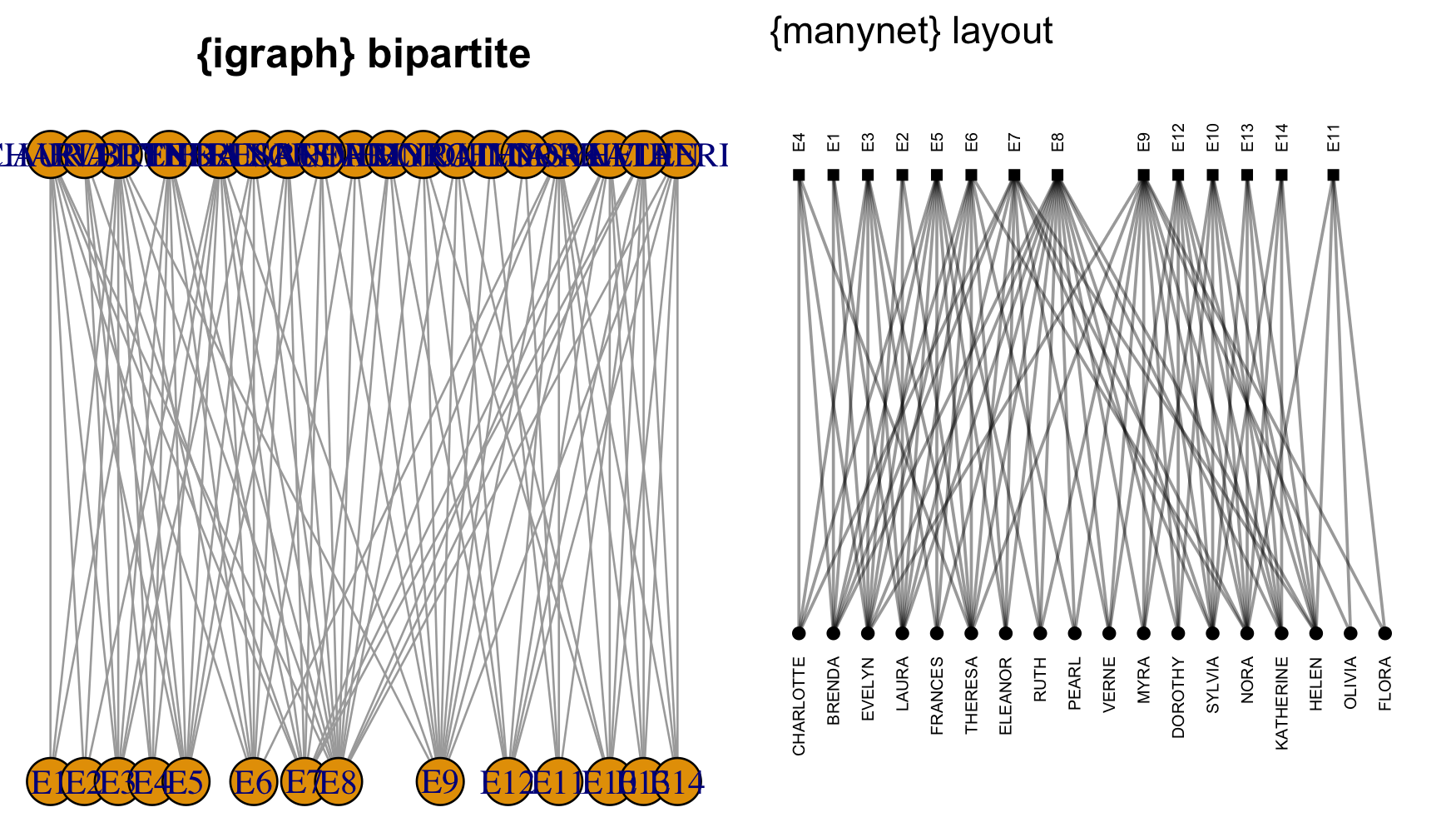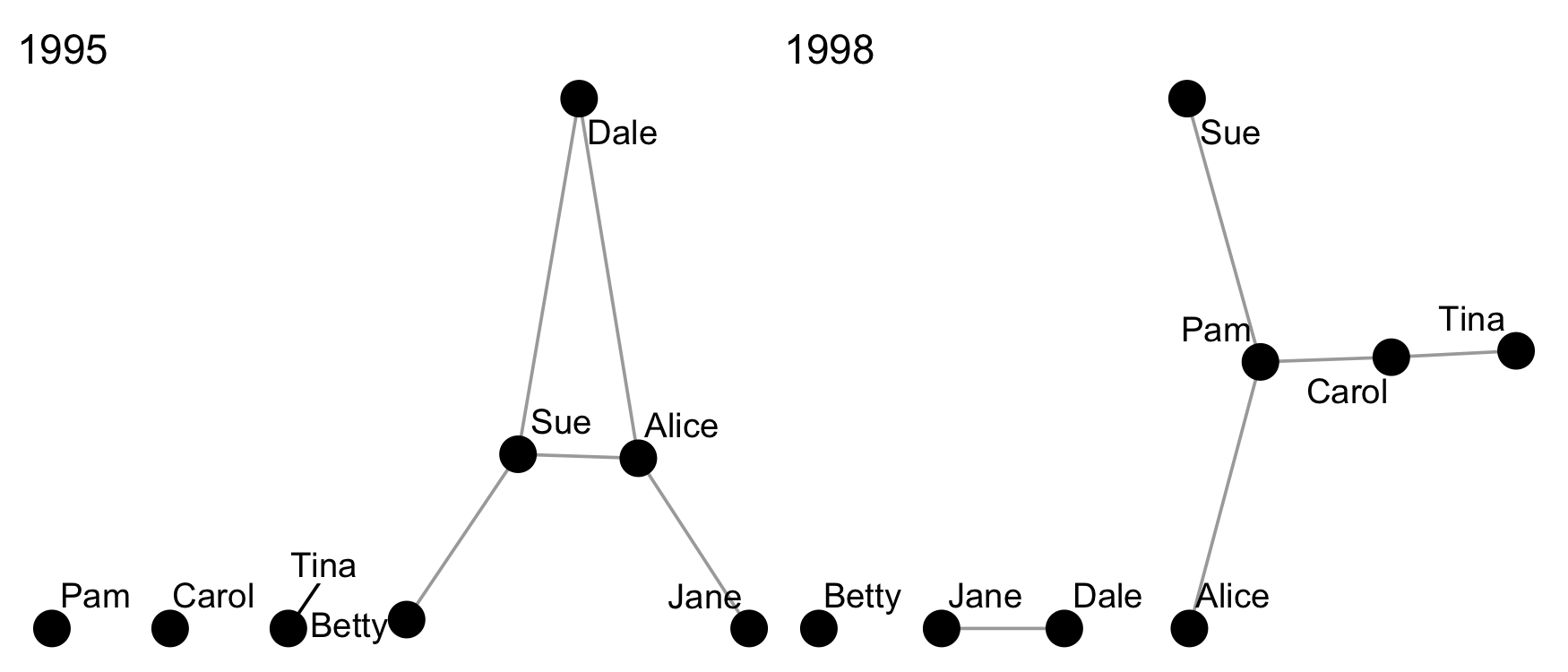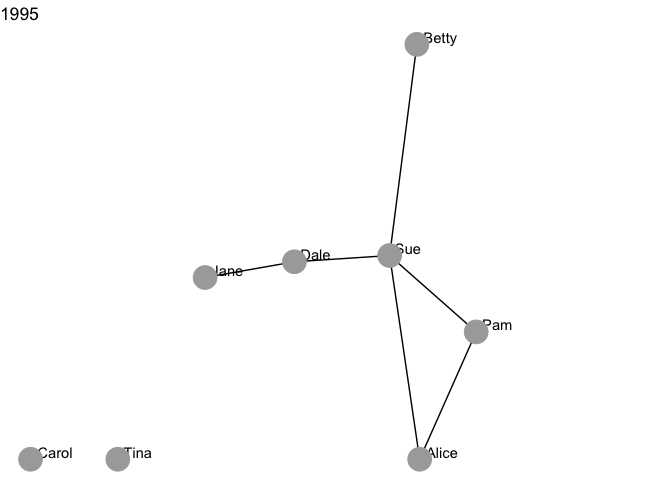

This package aims to make network visualisation easier, succinct, and consistent. Visualisation is a key part of the research process, from the initial exploration of data to the analysis of results and the presentation of findings in publications. However, it is often a tedious and time-consuming task. Trying to wrangle these into a consistent style for publication or presentation can be frustrating and requires a lot of code. While there are a number of excellent packages for network analysis in R, they each face several of the following challenges when it comes to visualisation:
{autograph} aims to solve these problems by providing
automatic graph drawing for networks in any of the
{manynet} formats, and automatic plotting for results from
{stocnet} packages, including {migraph},
{RSiena}, and {MoNAn}, and more.
All you need to do is install the package (loading it last will make
sure its plotting methods are the default), use
set_stocnet_theme() (once) to set your preferred theme, and
then use graphr() to graph your networks, or
plot() to plot your results. That’s it!
{autograph} includes three one-line graphing functions
with sensible defaults based on the network’s properties.
First, graphr() is used to graph networks in any of the
{manynet} formats. Because it builds upon
{manynet}, it can graph networks in any of the
{manynet} formats, including network,
igraph, sna, tidygraph, and
more.
Second, it includes sensible defaults so that researchers can view
their network’s structure or distribution quickly with a minimum of
fuss. Compare the output from {autograph} with a similar
default from {igraph}:

{igraph} requires the bipartite layout to be specified,
has cumbersome node size defaults for all but the smallest graphs, and
labels also very often need resizing and adjustment to avoid overlap.
Getting this default plot to look good can take a lot of trial and
error, and time. By contrast, graphr() recognises the
network as two-mode and uses a bipartite layout by default. It also
recognises that the network contains names for the nodes and prints them
vertically so that they are legible in this layout. Other ‘clever’
features include automatic node sizing and more.
All of graphr()’s adjustments can be overridden,
however… Changing the size and colors of nodes and ties is as easy as
specifying the function’s relevant argument with a replacement,
e.g. node_color = "darkblue" or node_size = 6,
or indicating from which attribute it should inherit this information,
e.g. node_color = "Office" or
node_size = "Seniority".

Legends are added by default when node or tie aesthetics are mapped
to attributes, but can be removed with show_legend = FALSE.
Since the {autograph} builds upon {ggplot2},
titles, subtitles and, for plotting, axis labels can all be added on
easily, or other elements (e.g. font size) can be tweaked for a
particular output.
graphr() can use all the layout algorithms offered by
packages such as {igraph}, {ggraph}, and
{graphlayouts}. {autograph} also offers some
additional layout algorithms for visualising partitions horizontally,
vertically, or concentrically, conforming to configurational
coordinates, or for snapping these layouts to a grid.

The second graph drawing function included, graphs(), is
used to graph multiple networks together. This can be useful for ego
networks or network panels. {patchwork} is used to help
arrange individual plots together, and is used throughout the package to
help arrange plots together informatively.

The third graph drawing function, grapht(), is used to
visualise dynamic networks. It uses {gganimate} and
{gifski} to create a gif that visualises network changes
over time. It really couldn’t be easier.

Since network analysis involves not just drawing graphs,
{autograph} also provides a function for plotting results
from the analysis or modelling of those networks. To keep things simple,
all users need to remember is a single, generic function:
plot(). Method dispatching takes care of the rest, so you
can concentrate on exploring and interpreting your results. Here are
some examples, using goodness-of-fit results from fitting a SAOM in
{RSiena} and an ERGM in {ergm}. (Note that
neither the data nor the model are similar; this is just for
illustrative purposes.)


Note that in the above plots, the same colour scheme and fonts were
used. They can be easily changed though. {autograph}
includes a number of themes that can be used to style all graphs and
plots consistently. And it is very easy to set a theme. Just type
stocnet_theme() to see which is the theme currently set,
and to get a list of available themes. Then enter the chosen theme name
in the function to set it. All plots created using
{autograph} functions will then use this theme, until you
change it again.
stocnet_theme()
(plot(node_degree(ison_karateka)) +
plot(tie_betweenness(ison_karateka)))/
(plot(node_in_regular(ison_southern_women, "e")) +
plot(as_matrix(ison_southern_women),
membership = node_in_regular(ison_southern_women, "e")))
stocnet_theme("ethz")
(plot(node_degree(ison_karateka)) +
plot(tie_betweenness(ison_karateka)))/
(plot(node_in_regular(ison_southern_women, "e")) +
plot(as_matrix(ison_southern_women),
membership = node_in_regular(ison_southern_women, "e")))
There are a range of institutional and topical themes available, including default, bw, crisp, neon, iheid, ethz, uzh, rug, unibe, oxf, unige, cmu, iast, hwu, rainbow, with more on the way.


If your institution or organisation is not included and you would like it to be, please just raise an issue on Github, along with a link to your corporate branding or style guide if available, and we will attempt to add it at the next opportunity.
In sum, while there is a lot of clever defaults and customisation available, all it takes is three simple functions for your
The easiest way to install the latest stable version of
{autograph} is via CRAN. Simply open the R console and
enter:
install.packages('autograph')
library(autograph) will then load the package and make
the data and tutorials (see below) contained within the package
available.
For the latest development version, for slightly earlier access to new features or for testing, you may wish to download and install the binaries from Github or install from source locally. The latest binary releases for all major OSes – Windows, Mac, and Linux – can be found here. Download the appropriate binary for your operating system, and install using an adapted version of the following commands:
install.packages("~/Downloads/autograph_winOS.zip", repos = NULL)install.packages("~/Downloads/autograph_macOS.tgz", repos = NULL)install.packages("~/Downloads/autograph_linuxOS.tar.gz", repos = NULL)To install from source the latest main version of
{autograph} from Github, please install the
{remotes} package from CRAN and then:
remotes::install_github("stocnet/autograph")remotes::install_github("stocnet/autograph@develop")Those using Mac computers may also install using Macports:
sudo port install R-autograph
Development on this package has been funded by the Swiss National Science Foundation (SNSF) Grant Number 188976: “Power and Networks and the Rate of Change in Institutional Complexes” (PANARCHIC).